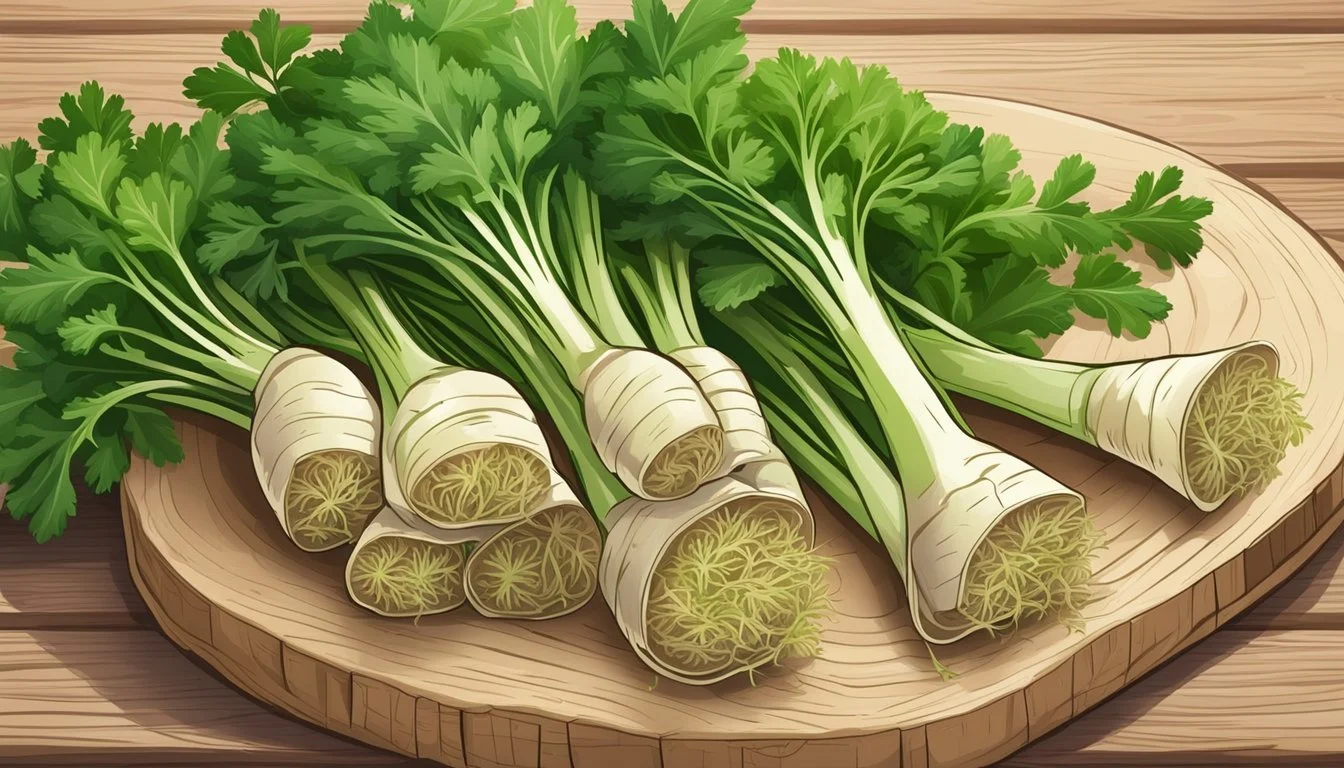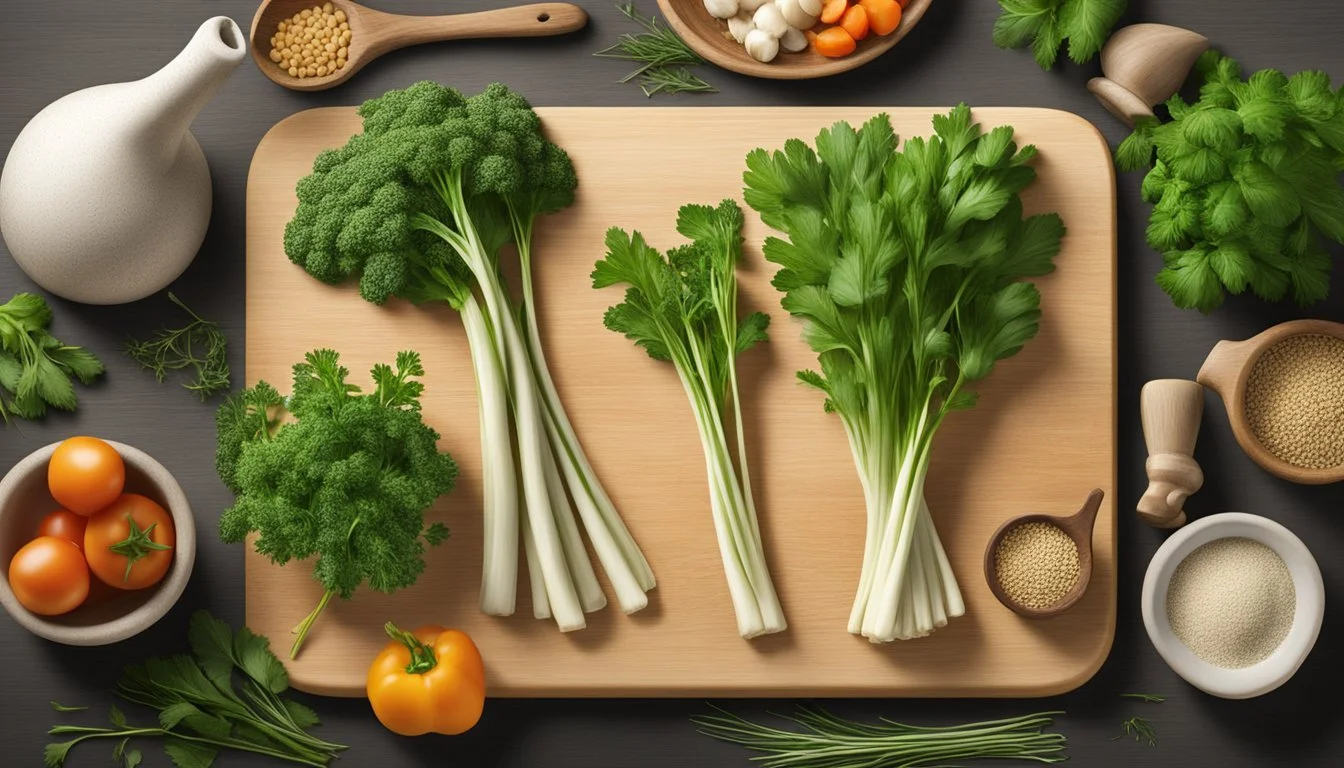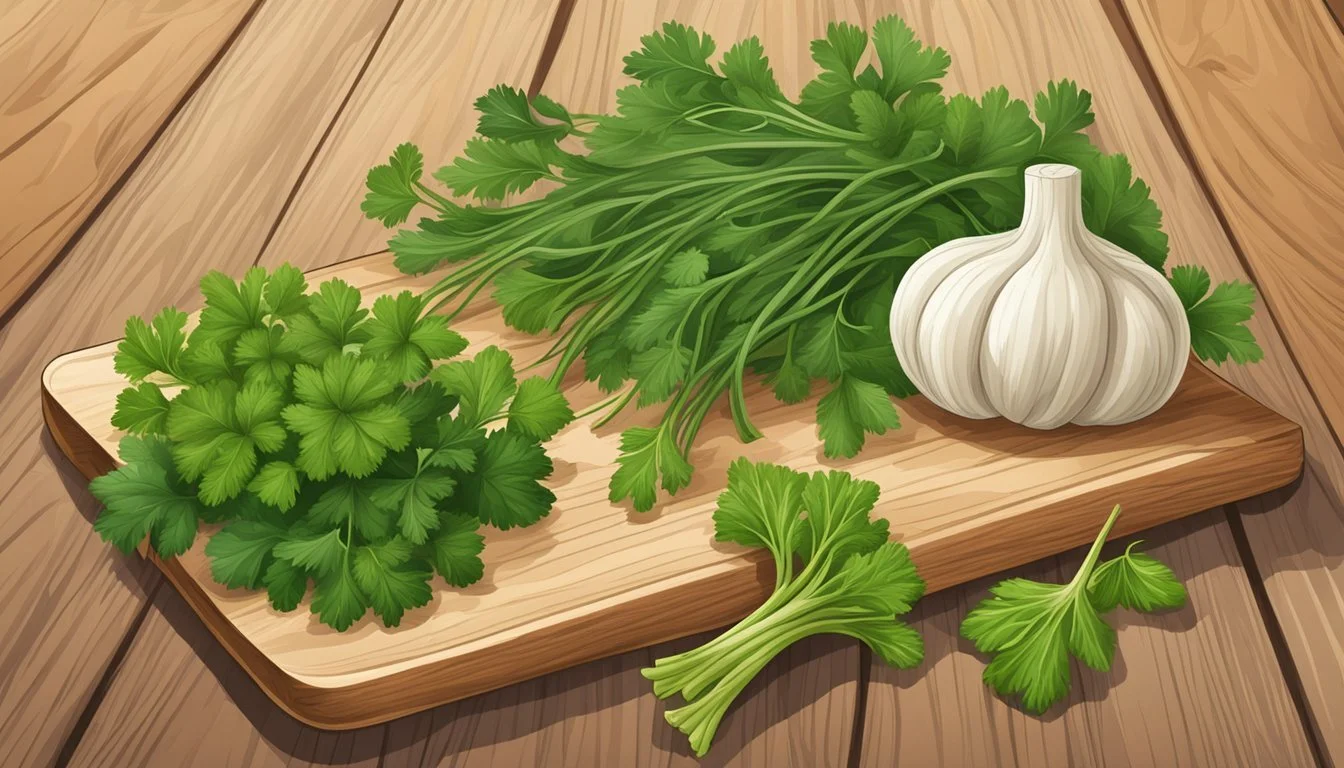Parsley Root Substitutes
Best Alternatives for Cooking
Struggling to find parsley root for your recipes? Look no further, as there are several excellent substitutes that can match its unique flavor and versatility. Celery root, also known as celeriac, stands out with its mild celery taste and smooth texture, making it an ideal replacement in many dishes. Mashing or pureeing celery root can provide a similar consistency to parsley root.
For a hint of bitterness similar to parsley root, carrot greens can be a viable option. They work well in soups, sauces, and salads, offering a slight celery flavor. Another alternative to consider is chervil, which is closely related to parsley and can easily replace it in garnishes and flavoring.
Don't overlook the potential of marjoram and dill as substitutes. Marjoram offers a mild, sweet, and floral aroma, while dill brings a fresh, tangy taste to fish, potatoes, and falafel. These substitutes ensure your cooking remains flavorful and nuanced, even when parsley root isn't available.
Understanding Parsley and Its Uses
Parsley is a versatile herb used in many culinary traditions for its distinct flavors and garnishing properties. It comes in different varieties and offers specific roles in various dishes.
Types of Parsley
Parsley primarily comes in two types: curly parsley and flat-leaf parsley.
Curly parsley is known for its decorative frilly leaves. It is commonly used as a garnish in dishes due to its aesthetic appeal and mild flavor.
Flat-leaf parsley, also known as Italian parsley, has a more robust and pronounced flavor, making it suitable for cooking. This type is often favored in Mediterranean and Middle Eastern cuisines, particularly in dishes like tabbouleh and bouquet garni.
Understanding the differences between these types helps in choosing the right one for recipes.
Roles in Culinary Applications
Parsley serves several key roles in cooking.
As a garnish, it adds a fresh, vibrant look to dishes. Fresh parsley is often sprinkled over soups, stews, and salads to enhance visual appeal and add a subtle flavor.
In cooking, parsley provides a delicate taste that complements a variety of dishes. It pairs well with ingredients in soups, sauces, and marinades. Parsley is also a fundamental component of the traditional bouquet garni, used to flavor broths and stews.
Parsley's versatility in flavor and presentation makes it a staple in many kitchens.
Common Parsley Substitutes
When parsley is unavailable, there are several herbs and greens that can effectively replace it in various recipes.
Herbs With a Similar Profile
Chervil is often seen as a milder cousin to parsley. Its delicate, slightly anise-like taste blends well in soups, sauces, and salads. Chervil leaves add depth to dishes without overshadowing other flavors.
Tarragon can also stand in for parsley. It has a subtle, peppery flavor that pairs well with poultry, fish, and egg dishes. Tarragon's versatility makes it a strong substitute, enhancing a variety of recipes.
Dried Chives are another option, offering a mild onion-like taste. They work well as a garnish and in cooked dishes where fresh parsley might be used.
Greens as Alternative Options
Carrot Greens resemble parsley in appearance and have an earthy-bitter taste with hints of celery. They can be used in soups, stews, and salads, making them a practical substitute.
Celery Leaves bring a similar flavor profile to the table, with a slightly pronounced celery taste. These leaves can add a refreshing element to soups, stocks, and garnishes.
These green alternatives not only mimic the flavor profile of parsley but also add a similar visual appeal to dishes.
The Essentials of Choosing Substitutes
When selecting a substitute for parsley root, it's important to consider factors such as flavor compatibility, availability, and how it can be integrated into various recipes.
Flavor Matching
Flavor matching ensures that the chosen substitute aligns with the dish’s intended taste. Parsley root has an earthy, slightly sweet flavor. Suitable alternatives should possess similar profiles.
Turnips: These offer earthy notes and a bit of sweetness, closely mimicking parsley root.
Parsnips: With a similar texture and subtly sweet flavor, they are excellent substitutes.
Matching flavor profiles helps maintain the desired taste balance in the dish.
Availability and Freshness
Availability of substitutes is crucial for cooking success. Freshness directly affects the flavor and nutritional value of the ingredient.
Turnips: Widely available in most markets.
Parsnips: Common in both fresh and frozen forms.
Ensure substitutes are fresh. Check for firm texture and vibrant color. Avoid any that are wilted or discolored.
Substitute Parsley in Recipes
Choosing the right substitute helps maintain the integrity of the recipes. Here are a few practical tips:
Salads and Side Dishes: Turnips can be added raw or lightly cooked, preserving their crunchiness.
Soups and Stews: Parsnips integrate well, providing a similar texture and flavor enhancement.
Boiled or Roasted: Both turnips and parsnips can replace parsley root in these preparations, retaining the earthy essence of the original ingredient.
Substitutes should seamlessly integrate into the dish, ensuring the final outcome remains delicious and authentic.
Herbal Substitutes for Parsley
Parsley is often replaced in dishes with other herbs that bring a unique flavor and aroma. Suitable alternatives include basil, dill, oregano, and cilantro.
Basil as a Versatile Herb
Basil offers a sweet and slightly peppery flavor. It pairs well with Italian dishes, salads, and even soups.
Fresh basil leaves can be used as a garnish or ingredient due to their pleasant aroma and taste. Basil is best added at the end of cooking to maintain its bright flavor.
When substituting, use an equal amount of fresh basil for fresh parsley. For dried basil, use half the amount compared to dried parsley, as dried herbs are more concentrated.
Dill's Unique Character
Dill brings a distinctive, slightly bitter taste and a hint of anise. It's commonly used in European cuisines, especially in pickling and seafood dishes.
Fresh dill fronds are great for garnishing, while the seeds can add depth in cooking. Dill retains its flavor better than many other herbs during cooking, making it versatile.
When using dill as a parsley substitute, it's best employed in lighter dishes where its delicate flavor can shine without overpowering other ingredients.
Oregano's Robust Flavor
Oregano is known for its bold, robust flavor which is somewhat bitter and peppery. It’s a key component in Mediterranean and Mexican cuisines.
Fresh oregano leaves can be used similarly to parsley, although their robust flavor may require using a smaller amount. Dried oregano is very potent, so use it sparingly.
Oregano works well in tomato-based dishes, meats, and sauces. When substituting for parsley, particularly in heavily seasoned recipes, oregano provides an excellent complement.
Cilantro for a Bright Note
Cilantro offers a bright and slightly citrusy flavor that livens up dishes. It's prominent in Latin American and Asian cuisines.
Fresh cilantro leaves are ideal for garnishing or being added to dishes right before serving. Cilantro should be used in a one-to-one ratio when replacing parsley.
Due to its bright and fresh taste, cilantro is perfect for salsas, salads, and various cooked dishes. Unlike parsley, cilantro should be added late in the cooking process to preserve its flavor.
Leafy Green Substitutes for Parsley
Several leafy greens can effectively replace parsley, providing similar flavors and textures. Below is a closer look at how arugula can serve as a substitute.
Arugula's Peppery Edge
Arugula, a type of leafy green, offers a mild peppery flavor similar to parsley. It's slightly bitter, adding a distinct twist to dishes.
Arugula can be used fresh in salads and as a garnish. Its peppery taste works well in soups, stews, and sauces, complementing various ingredients. Unlike parsley, arugula adds a unique depth, making it ideal for recipes requiring a bolder flavor. It’s a versatile green that enhances numerous dishes.
By incorporating arugula, the nutritional profile of meals can be improved with its high levels of vitamins A and K.
Specialty Herbs as Substitutes
Specialty herbs like chervil and tarragon offer unique nuances that can effectively replace parsley root in various dishes. Exploring their distinct flavors and ideal uses highlights their potential as great alternatives.
Chervil's Subtle Flavor
Chervil, often referred to as "French parsley," provides a delicate and slightly anise-like flavor. This mild herb is ideal for dishes requiring a gentle taste that won't overpower other ingredients. The subtle flavor of chervil leaves makes them perfect for seasoning soups, salads, and light sauces.
In addition to flavor, chervil’s fine, feathery texture resembles that of parsley, adding visual appeal to dishes. Its mildness is especially useful in French cuisine, particularly in fines herbes, a mixture of parsley, chives, tarragon, and chervil. Whether used fresh or dried, chervil offers a versatile substitute for parsley root, maintaining the desired taste balance.
Tarragon's Distinct Taste
Tarragon stands out with its strong, licorice-like taste. This herb is bolder than chervil, providing a robust flavor that works well in dishes requiring a pronounced taste. Dried tarragon retains most of its intense aroma and potency, making it an effective larder staple.
Tarragon pairs excellently with poultry, seafood, and egg dishes, enhancing flavors without overpowering them. Its distinctive taste makes it a staple in Béarnaise sauce and other classic French recipes. When considering a substitute for parsley in recipes that need a flavor boost, tarragon can be an excellent choice, especially when a peppery edge is desired.
Fines Herbes Classic Blend
Fines Herbes is a foundational element of French cuisine known for its delicate aroma and flavor. This classic blend typically consists of four fresh herbs: parsley, tarragon, chives, and chervil.
Parsley brings a slightly peppery and fresh taste. It's a versatile herb that pairs well with the other fines herbes, contributing to the overall harmony.
Tarragon adds a distinctive anise-like flavor. It's essential for dishes like bearnaise sauce and is often used to enhance chicken, fish, and vegetable dishes.
Chives provide a mild onion-like taste without being overpowering. They are excellent for adding subtle depth to dishes, especially those involving eggs, such as omelets and quiches.
Chervil features a delicate flavor similar to parsley but with a slight hint of anise. Often used in French cooking, it complements the other fines herbes perfectly.
Fines Herbes Mix Preparation
To prepare a fresh fines herbes mix, finely chop equal parts of these herbs and combine them. Use the blend immediately to retain the fresh flavor or freeze it for later use.
Usage of Fines Herbes
Egg dishes: Ideal for enhancing omelets, scrambled eggs, and quiches.
Sauces: Perfect for recipes like bearnaise or beurre blanc.
Salads: Can be used as a salad green or sprinkled over salads for added freshness.
Vegetables: Works well in vegetable dishes for a nuanced flavor profile.
Whether fresh or dried, fines herbes adds a refined touch to many recipes, making it a staple in any kitchen striving for classic French elegance.
Chimichurri's Vibrant Mix
Chimichurri is a flavorful and versatile sauce that originates from Argentina. It's traditionally made using fresh herbs, garlic, vinegar, and olive oil. The vibrant mix of these ingredients creates a sauce that can be used as a marinade or condiment.
To make chimichurri, a food processor is often used. The basic ingredients are blended until finely chopped but not transformed into a paste. This preserves the sauce's texture.
Common Ingredients:
Fresh parsley or cilantro
Red wine vinegar
Olive oil
Red chili or crushed red pepper
Salt and pepper
The choice of herbs can be adjusted according to preference. Parsley is the traditional herb, but cilantro offers a different flavor profile, making the sauce equally delightful.
When using dried herbs like parsley, it's essential to rehydrate them first. Soaking dried herbs in warm water helps retain their flavors and texture in the final mix.
Steps for Making Chimichurri:
Chop Herbs: Fresh or rehydrated.
Pulse in Food Processor: Add garlic, oregano, and chili.
Add Vinegar and Oil: Blend gently.
Season: Salt and pepper to taste.
Rest: Let sit 15 minutes to mesh flavors.
Chimichurri can vary slightly based on personal tastes, such as altering the herb selection or adjusting the heat from chilis. These variations maintain the essence while personalizing this beloved sauce.









